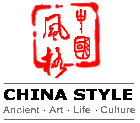De'ang Clothes
De'ang women generally wear dark blue or black short jackets with buttons down the front that is inlaid with two strips of red cloth and sewn with four to five square silver fasteners. They wear colorful long skirts with horizontal stripes, covering the breasts and reaching the ankles. Women of different clans are distinguished by the color and designs of their skirts. Women from the Liang (a branch of De'ang people) wear skirts with blue and red stripes. The Bielie women wear skirts with several scarlet horizontal stripes measuring 5 to 6 inches wide at the lower hem, and those from the Raomai women wear skirts with red, green and white thin stripes on the dark blue background. Women do not keep hair, but shave their heads bald and wear kerchief. And, the two ends of the kerchief droop down the back like two plaits. But women of Raomai branch keep hair after their marriage. They wear short jackets with buttons down the right and the upper part of their skirts only reaches the waist.
De'ang men usually wear indigo or black robes buttoned on the right together with short broad trousers. They used to wrap their heads with black or white kerchiefs decorated with colored pile beads on two sides. However, nowadays, many De'ang boys have the same hairstyle as the Hans and do not like to burden their heads with so many ornaments. In some areas, men have the custom of tattooing their bodies with designs of tiger, deer, bird and flowers.
To add to their charm, young people, no matter male or female, put on silver neck rings, earrings and large silver earbobs, etc. Women usually decorate their jackets with red, yellow or green velvet balls on the lower hem. Men and women decorate some colorful velvet balls at the two ends of the kerchiefs. Young men always hang a string of five-color velvet balls on the breast while girls decorate their collars with velvet balls.
Waist Hoops: the Favorite of De'ang Girls
Southwest China's Yunnan Province is home to many ethnic minority groups, whose beautiful and dazzling costumes, unique lifestyles, colorful festivals and exotic marriage customs attract a significant number of visitors. One such minority group is the De'ang minority group, which is scattered in Dehong Region in the province's southwestern part. The most striking feature of De'ang people's costumes is the waist hoops worn by De'ang girls.
Meaning of the Waist Hoops
According to De'ang customs, a grown-up girl has to wear several or dozens of waist hoops around the waist between her black corset and little skirt. Although most hoops are woven with vine stripes, there are also hoops whose back part is made with spiral silver wires. Hoops of different sizes are mostly painted colors such as red, black or green, and some are carved with various design patterns, or covered with a silver or aluminum wrapper. When a De'ang girl walks, the hoops move with her body, producing pleasant sounds and looking very beautiful.
In De'ang people's eyes, waist hoops have particular meanings, and have become a symbol of beauty. The more hoops a girl wears and the more exquisite the hoops are, the smarter and more capable De'ang people consider the girl. Thus any girl who does not wear a hoop will be laughed at. Besides, young people in love often choose to give a waist hoop to each other as a token of their love.
Origin of the Waist Hoop
The unique custom of wearing waist hoops dates back to the Tang Dynasty when the ancestors of De'ang ethnic group- the Mang Tribe wore vine strips around their waists for decoration. As a tale goes, the ancestors of De'ang people, male and female, were all born in a gourd, but all the men were the same in appearance. Unwilling to live with those men, the women flew everywhere, with their feet never touching the ground. Later, a God of Heaven painted the men's faces into a wide variety. However, the women were still unwilling to live with them. With no choice, the men used vine strips to bind the women to the ground. Unable to fly, the women were forced to live with the men. From then on, vine stripes have been kept on the waist of De'ang women.


